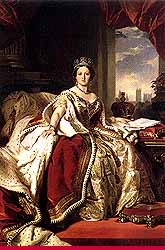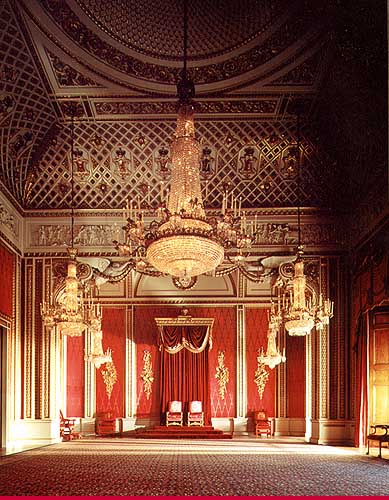 |
QUEEN VICTORIA
 |
Portrait of Queen
Victoria in her
Coronation robes
and wearing the
State Diadem, by
Franz Xavier
Winterhalter
© Royal Collection
 |
|
William was
succeeded by his niece, Victoria (reigned 1837-1901), aged 18. As women
could not inherit the Hanoverian throne that throne passed to Victoria's
uncle; the union with Hanover had lasted 123 years. During the early years
of her reign, Victoria was heavily influenced
Victoria's long reign coincided with a fundamental change in the nature of the British monarchy by which its power declined and was replaced by influence. In 1837 the government was still seen to a large extent as the Sovereign's government. However, the defeat of Melbourne's government in the 1841 general election meant that for the first time, the electorate had in effect chosen a Prime Minister (Peel) against the Sovereign's wishes. But since the political groups in Parliament were now wholly cohesive and none could form a majority on its own, the Queen could still exert influence. The coalition government of 1852, led by Aberdeen, was the last to be brought into existence by royal initiative, but royal support could not sustain this coalition when it was accused of incompetence during the Crimean War and it fell in 1855. With the growth of the two-party system, which increasingly limited the Queen's power to choose her Prime Minister, her influence was directed more towards matters of government policy particularly foreign affairs and she was occasionally able to mediate in political crises. In 1856, the
Queen instituted the Victoria Cross, which was the highest award for valour
open to all ranks, made from Russian guns captured in the Crimean War.
In 1877,
The Monarchy's importance increased at home and abroad. During Victoria's reign, the spread of self-government in the colonies (Dominions) coincided with growth in imperial sentiment and the Queen's personal prestige. In 1897 the Queen celebrated her Diamond Jubilee amid scenes of popular enthusiasm. She had reigned longer than any other British monarch. |
The silver-gilt
|